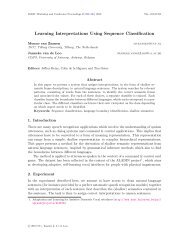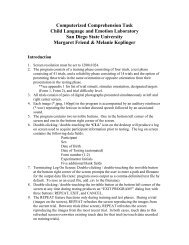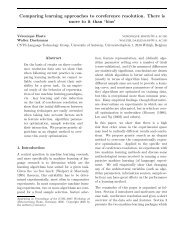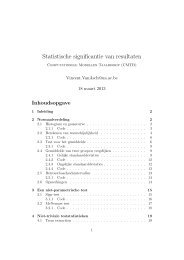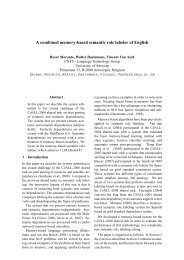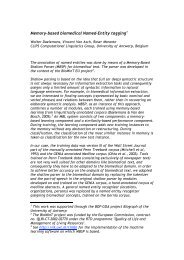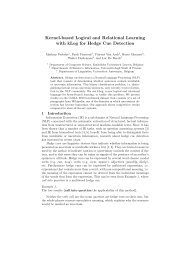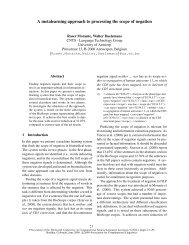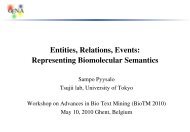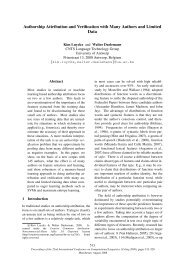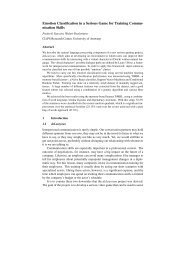Atila 2011 (Antwerp, 1-2 December) Schedule & Abstracts - CLiPS
Atila 2011 (Antwerp, 1-2 December) Schedule & Abstracts - CLiPS
Atila 2011 (Antwerp, 1-2 December) Schedule & Abstracts - CLiPS
Create successful ePaper yourself
Turn your PDF publications into a flip-book with our unique Google optimized e-Paper software.
In the past, Error-Correcting Error Codes (ECOCs) have been used successfully toimprove performance in text classification tasks (Dietterich and Bakiri, 1995). Weinvestigate whether ECOCs remain effective for difficult classification tasks with limiteddatasets. We compare the performance of different codeword matrices, including acodeword matrix that takes the natural subdivisions of the classification framework intoaccount. We compare these ECOC approaches to the more common one vs. all approachand a multiclass classifier. We observe that using ECOCs doesn’t guarantee animprovement in classification performance, and that any gain to be had from using anECOC setup will depend on the difficulty of the underlying classification task.- Handling skewed data: Class division (Menno van Zaanen)Many of the datasets we use as training and testing data in machine learning classificationtasks is skewed. In this case, there is (typically only) one class that occurs much morefrequently than the other classes. The existence of this large class has several effects on thetask, which can be seen in the evaluation.Having skewed data leads to a majority class baseline that is, perhaps unreasonably, high,but more importantly it may also have a negative effect on the results of the classificationsystem. The areas in the instance space that contain instances of the non-majority classesare simply overwhelmed by the areas of the majority class.A typical solution to the effects of skewed data is to perform downsampling. In this case,instances of the majority class as removed from the dataset randomly. This reduces theinfluence of the majority class, but at the same time has the negative effect that potentiallyinteresting instances are simply removed from the dataset.Another alternative, which we propose here, is to divide the majority class into multipleclasses. The system keeps track of the new classes as being part of the original majorityclass, which means that no information is lost. However, the effect of the skewedness ofthe dataset is reduced. The major advantage of this approach is that no data instanceshave to be thrown away.- Applying domain similarity to unsupervised training data construction (Vincent van Ashand Walter Daelemans)11.00-11.30: Coffee breakWhen resources are scarce, additional training data can be obtained by labeling rawcorpora and adding the newly labeled data to the training data. This unsupervised methodcan also be applied when cross-domain experiments are carried out. As has been shown inprevious work, it is possible to measure the degree of similarity of corpora. Test data thatis more similar to the training data will lead to better performance. The underlyinghypothesis of the ongoing research here presented is that data that is more similar to thetest data is more suited to be added to the training data. Preliminary results indicate thatthis hypothesis is valid although labeling accuracy has an influential role.11.30-12.30: Session 4 – Networks (chair: Kim Luyckx, 3 talks)- The Socialist Network (Matje van de Camp)We develop and test machine learning-based tools for the classification of personalrelationships in biographical texts, and the induction of social networks from theseclassifications. A case study is presented based on several hundreds of biographies of4



